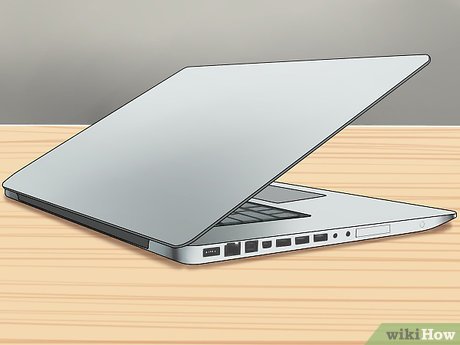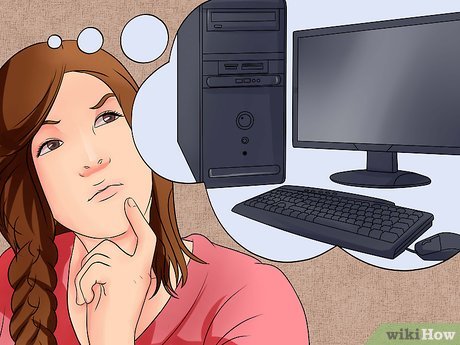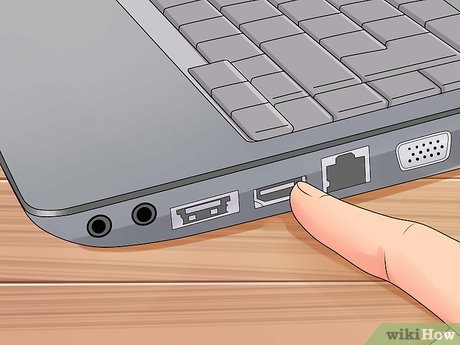How to Set Up Dual Monitors
This wikiHow teaches you how to set up a two-monitor display for your Windows or Mac computer. Using two monitors for one display effectively doubles the amount of on-screen space with which you have to work. Know that most laptops can...
Part 1 of 4:
Checking Second Monitor Support
-
 Know that most laptops can support dual monitors. If you have a laptop which has at least one video output slot (e.g., an HDMI port or a VGA port), you can usually use an external monitor in conjunction with the video port.
Know that most laptops can support dual monitors. If you have a laptop which has at least one video output slot (e.g., an HDMI port or a VGA port), you can usually use an external monitor in conjunction with the video port.- While a few Windows laptops might not support dual monitors, all Apple MacBook computers do—if you have a Mac laptop, feel free to skip ahead to connecting your second monitor.[1]
-
 Understand that not all desktop computers support dual monitors. Depending on your computer's graphics card and motherboard, you may not be able to run a second monitor at the same time as your first.[2]
Understand that not all desktop computers support dual monitors. Depending on your computer's graphics card and motherboard, you may not be able to run a second monitor at the same time as your first.[2]- Again, if you're using an Apple iMac desktop unit, you can use dual monitors.
-
 Check your computer's video output ports. Most computers have at least two ports for video output, meaning that you'll usually be able to connect a second monitor; however, if the two (or more) ports aren't level with each other, they're most likely not part of the same graphics card and thus not able to be used for dual monitors.[3]
Check your computer's video output ports. Most computers have at least two ports for video output, meaning that you'll usually be able to connect a second monitor; however, if the two (or more) ports aren't level with each other, they're most likely not part of the same graphics card and thus not able to be used for dual monitors.[3]- For example, if you see two horizontal HDMI ports next to (or on top of) each other, your computer's graphics card probably supports dual monitors. This goes for different outputs as well (e.g., a VGA output next to an HDMI output).
- Desktop Windows computers normally have these ports on the back of the computer case.
- If you only see one video output on a desktop computer, your computer's graphics card only supports one monitor at a time. Laptops which have one video output port can usually support multiple monitors.
-
 Determine whether your motherboard supports dual monitors. Virtually all modern computers' motherboards support multiple monitors, but older machines may not. You can check your motherboard for dual monitor support by doing the following:
Determine whether your motherboard supports dual monitors. Virtually all modern computers' motherboards support multiple monitors, but older machines may not. You can check your motherboard for dual monitor support by doing the following:- Find your motherboard's name.
- Look up your motherboard's name in a search engine (e.g., Google).
- Select a search result which lists your motherboard's features.
- Look for a "Multi-Display", "Multi-Monitor", or "Dual Display" feature.
Part 2 of 4:
Connecting the Second Monitor
-
 Determine your computer's video connection type. On the back of your computer's CPU box (or monitor if you're using an iMac), you should see several ports, one of which is currently being used for your main monitor. Common connection ports include the following:
Determine your computer's video connection type. On the back of your computer's CPU box (or monitor if you're using an iMac), you should see several ports, one of which is currently being used for your main monitor. Common connection ports include the following:- DVI — A wide piece of plastic with numerous small square holes in it.
- VGA — A trapezoid-shaped piece of colored plastic with several pinholes in it.
- HDMI — A thin, flat, hexagonal port. These are on most modern computers and TVs.
- DisplayPort — Similar to HDMI, but has a flat edge on one side instead of being symmetrical.
- Thunderbolt — Found on the backs of most iMac monitors, the Thunderbolt connection has a lightning bolt icon beneath it. You can connect an adapter for any of the above video connections to a Thunderbolt port (e.g., VGA to Thunderbolt).[4]
-
 Check the second monitor's connection type. Your second monitor should have at least one of the previously mentioned connection types. You don't have to use the same connection that you use for your first monitor on your second monitor.
Check the second monitor's connection type. Your second monitor should have at least one of the previously mentioned connection types. You don't have to use the same connection that you use for your first monitor on your second monitor.- For example, you can attach the first monitor using a DisplayPort cable and attach the second monitor using HDMI.
- In some cases, you might be able to set up a second monitor wirelessly. For example, to use an iPad as a second monitor, you can connect it to some computers wirelessly using an app called Air Display.
-
 Buy any cables or adapters that you don't have. If you don't have the proper cable or adapter that you need to attach your second monitor to the computer, you can find it online or in a tech department store.
Buy any cables or adapters that you don't have. If you don't have the proper cable or adapter that you need to attach your second monitor to the computer, you can find it online or in a tech department store.- Especially if you're connecting a second monitor to an iMac, you'll need either a Thunderbolt cable or a port-to-Thunderbolt adapter for the back of the monitor.
-
 Connect the second monitor to the computer. Plug one end of the second monitor's video cable into the back of the computer, then plug the other end into the second monitor.
Connect the second monitor to the computer. Plug one end of the second monitor's video cable into the back of the computer, then plug the other end into the second monitor. -
 Connect the second monitor to a power source. Plug your monitor's power cable into an electrical outlet, such as a wall socket or a surge protector.
Connect the second monitor to a power source. Plug your monitor's power cable into an electrical outlet, such as a wall socket or a surge protector. -
 Turn on the second monitor. Press the "Power"button on the second monitor to make sure that it is turned on and ready to receive the signal from your computer's main monitor. You can now proceed with setting the display preferences for your monitor on Windows or on Mac.
Turn on the second monitor. Press the "Power"button on the second monitor to make sure that it is turned on and ready to receive the signal from your computer's main monitor. You can now proceed with setting the display preferences for your monitor on Windows or on Mac. EXPERT TIPChiara Corsaro is the General Manager and Apple Certified Mac & iOS Technician for macVolks, Inc., an Apple Authorized Service Provider located in the San Francisco Bay Area. macVolks, Inc. was founded in 1990, is accredited by the Better Business Bureau (BBB) with an A+ rating, and is part of the Apple Consultants Network (ACN).
EXPERT TIPChiara Corsaro is the General Manager and Apple Certified Mac & iOS Technician for macVolks, Inc., an Apple Authorized Service Provider located in the San Francisco Bay Area. macVolks, Inc. was founded in 1990, is accredited by the Better Business Bureau (BBB) with an A+ rating, and is part of the Apple Consultants Network (ACN).
Chiara Corsaro
General Manager of macVolks, Inc. Chiara Corsaro
Chiara Corsaro
General Manager of macVolks, Inc.In most cases, this is all you'll need to do. Typically, you just have to plug in your second monitor and turn it on, and your dual screen will automatically show up. However, if you want to make any adjustments, you'll just go into your 'System Preference' under 'Display Settings' to change how it's set up.
Part 3 of 4:
Setting Display Preferences on Windows
-
 Open Start. Click the Windows logo in the bottom-left corner of the screen.
Open Start. Click the Windows logo in the bottom-left corner of the screen.
-
 Open Settings. Click the gear-shaped icon in the lower-left side of the Start window.
Open Settings. Click the gear-shaped icon in the lower-left side of the Start window.
-
 Click System. It's a computer monitor-shaped icon in the Settings window.
Click System. It's a computer monitor-shaped icon in the Settings window. -
 Click the Display tab. You'll find this in the upper-left side of the window.[5]
Click the Display tab. You'll find this in the upper-left side of the window.[5] -
 Scroll down to the "Multiple displays" section. It's at the bottom of the page.
Scroll down to the "Multiple displays" section. It's at the bottom of the page. -
 Click the "Multiple displays" drop-down box. You'll find this box just below the "Multiple displays" heading. A drop-down menu will appear.
Click the "Multiple displays" drop-down box. You'll find this box just below the "Multiple displays" heading. A drop-down menu will appear. -
 Select a display option. In the drop-down menu, click one of the following options depending on your preferences:[6]
Select a display option. In the drop-down menu, click one of the following options depending on your preferences:[6]- Extend these displays (recommended) — Uses the second monitor as an extension of your first monitor.
- Duplicate these displays — Displays the first monitor's contents on the second monitor.
- Show only on 1 — Shows content only on the first monitor.
- Show only on 2 — Shows content only on the second monitor.
-
 Click Apply. It's below the drop-down box.
Click Apply. It's below the drop-down box. -
 Click Keep settings when prompted. Doing so will apply your display settings. If you chose to extend your desktop, you'll now see your desktop split between the first monitor and the second monitor.
Click Keep settings when prompted. Doing so will apply your display settings. If you chose to extend your desktop, you'll now see your desktop split between the first monitor and the second monitor.
Part 4 of 4:
Setting Display Preferences on Mac
-
 Open the Apple menu. Click the Apple logo in the top-left corner of the screen. A drop-down menu will appear.
Open the Apple menu. Click the Apple logo in the top-left corner of the screen. A drop-down menu will appear.
-
 Click System Preferences…. It's near the top of the Apple drop-down menu.
Click System Preferences…. It's near the top of the Apple drop-down menu. -
 Click Displays. You'll find this computer monitor-shaped icon in the upper-left side of the System Preferences window.
Click Displays. You'll find this computer monitor-shaped icon in the upper-left side of the System Preferences window. -
 Click the Arrangement tab. It's at the top of the page.
Click the Arrangement tab. It's at the top of the page. -
 Uncheck the "Mirror Displays" box. If you want to extend your desktop using the second monitor, make sure that the "Mirror Displays" checkbox is unchecked.
Uncheck the "Mirror Displays" box. If you want to extend your desktop using the second monitor, make sure that the "Mirror Displays" checkbox is unchecked.- If you want to display the same content on both monitors, you can leave the "Mirror Displays" box checked.
-
 Change your default display. If you want to use the second monitor as your main display, you can click and drag the white rectangle at the top of one of the blue displays onto the second display.[7]
Change your default display. If you want to use the second monitor as your main display, you can click and drag the white rectangle at the top of one of the blue displays onto the second display.[7]
5 ★ | 1 Vote
You should read it
- How to Set Up a Second Display with Windows
- Experience choosing to buy the best computer monitor
- How to Adjust, Tilt, and Turn Your Windows Screen
- Software display parameters and monitor PC hardware when playing games
- How to Mirror Your Screen on Windows
- What is the best color correction for the screen?
- How to Rotate Your Computer Screen
- Selecting a monitor for a computer
- Things you should know about LCD Monitor
- How to use a laptop as a second monitor
- How to Adjust Colors on an LCD Monitor
- Set up multi-monitor configuration in Vista


































 How to Set Different Wallpapers on Dual Monitors on Windows
How to Set Different Wallpapers on Dual Monitors on Windows How to set up dual monitors with HDMI
How to set up dual monitors with HDMI How to use 2 monitors on Windows 10
How to use 2 monitors on Windows 10 How to set up dual monitors with XRandR
How to set up dual monitors with XRandR Microsoft silently perfects dual screen support for Edge Chromium
Microsoft silently perfects dual screen support for Edge Chromium What is a dual SIM phone?
What is a dual SIM phone?